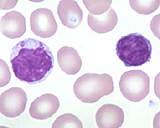Identify lymphocytes of various
sizes and with various amounts of cytoplasm (Fig. 12-11).
- Lymphocytes
are abundant, being approximately as numerous as neutrophils.
How does the agranulocytic nature of
lymphocytes correlate with their function?
 Identify the second type of
agranulocyte: the monocytes (Fig. 12-12), noting the distinctive size
and nuclear shape of these cells. Identify the second type of
agranulocyte: the monocytes (Fig. 12-12), noting the distinctive size
and nuclear shape of these cells.
When and where do monocytes become
functional?
 Identify platelets (thrombocytes)
(Fig. 12-13), noting their size, their lack of nuclei, their
distribution (singly or in clusters), and their ultrastructural
features. Identify platelets (thrombocytes)
(Fig. 12-13), noting their size, their lack of nuclei, their
distribution (singly or in clusters), and their ultrastructural
features.
How might the size and structural
features of platelets aid their function?
Sketch at the same scale examples of
mature circulating neutrophils, eosinophils, lymphocytes, and
monocytes.
So, where does
it all happen? |